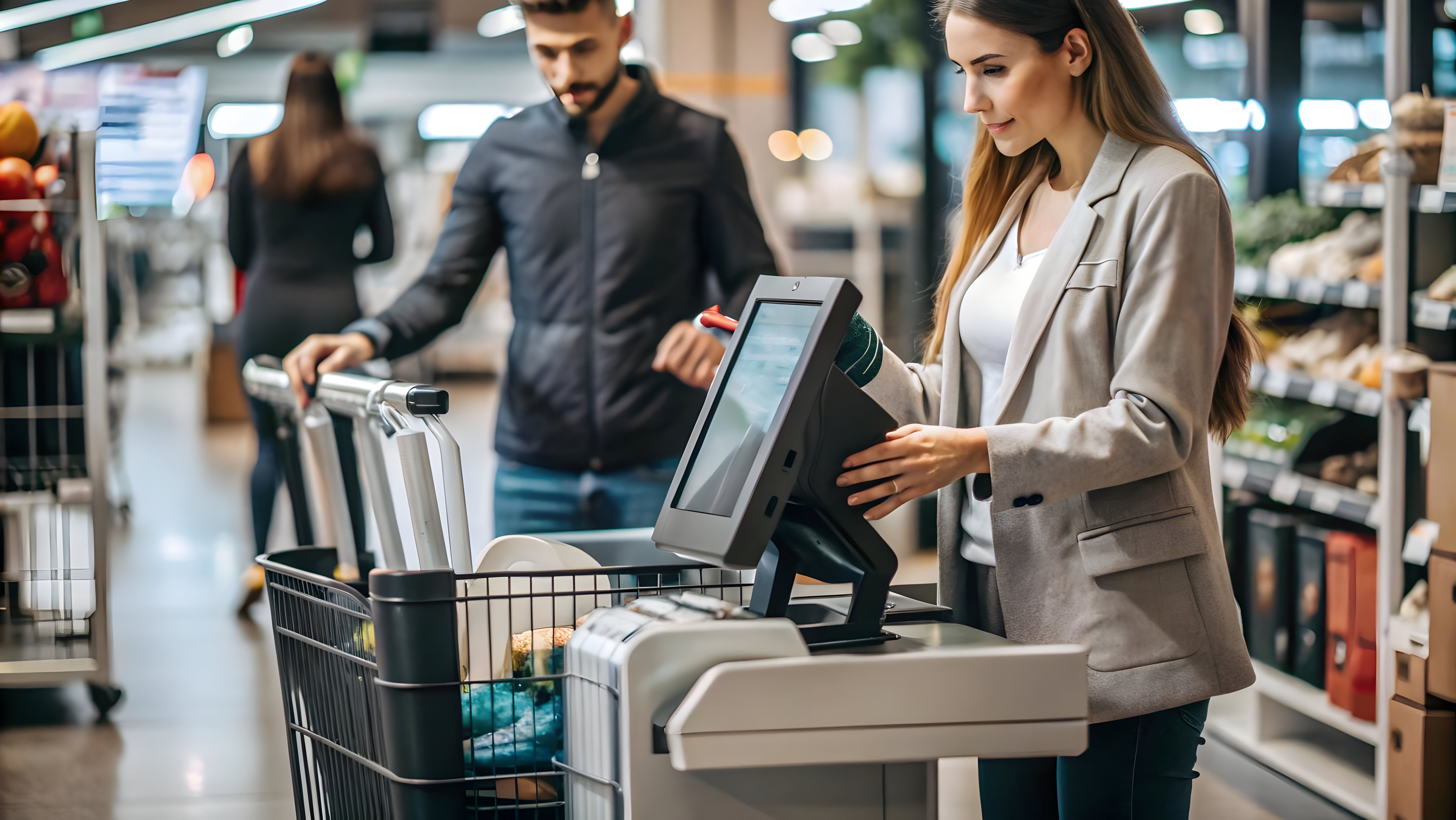Are you considering adopting a new system for your in-store payments?
You’ve come to the right place! This guide provides a practical explanation of everything you need to know about point of sale (POS) payment systems and the latest innovations in the field.
In short, everything you need to make an informed choice.
Find out more below…
What is a Point of Sale (POS) Payment System?
As you may already know, a point of sale (POS) is where the transaction between the customer and the business takes place for the purchase of goods or services.
This is where customers make their payments, usually using cash, credit or debit cards, or contactless payment solutions.
A point of sale (POS) payment system refers to the set of tools and devices used to complete this transaction.
Traditionally, these systems were represented by traditional cash registers. Nowadays, more advanced point-of-sale payment solutions are available, such as self-service checkouts, electronic payment terminals (EPTs), or SoftPOS solutions.
The operation of any POS system relies on a combination of hardware and software that work together to manage transactions.
Optimize Your Point of Sale Configuration with Ease
As mentioned earlier, point of sale (POS) systems have evolved significantly. They now integrate modern payment systems that simplify business operations and enhance the customer experience.
Merchants, store owners, etc., now have access to integrated solutions that not only allow them to accept various payment methods but also centralize inventory management, track real-time sales, and offer personalized services to customers.
These tools save merchants time, reduce human errors, improve customer satisfaction, and increase the overall efficiency of their business.
In-Store Payment: A Comprehensive, Integrated, and Seamless Solution
The Combination of PayWish and Pay On Site
Among the available solutions, the Pay On Site solution offers a reliable and efficient approach.
This solution supports multiple payment methods, such as bank cards and e-wallets.
It also allows for customer feedback collection and the display of targeted content to improve the shopping experience.
For international businesses, the Pay On Site payment terminal solution offers unique, centralized sales tracking across all points of sale in Europe.
PayWish goes even further in simplifying in-store payments.
With NFC payment through PayWish, merchants can bypass the need for traditional payment terminals like Pay On Site by using their smartphones.
Your device just needs to be NFC compatible!
Imagine being on the go, at a customer’s home, or during busy periods: no need to carry a payment terminal, as everything happens directly via your smartphone.
You can deploy a wide range of applications at no extra cost.
Additionally, integrating a SoftPOS solution like PayWish can be ideal if you’re looking for a payment solution for pop-up sales.
For businesses, this means simplified management and reduced fees.
Moreover, PayWish also offers a wide range of payment methods, including traditional bank cards.
Why Combine Pay On Site and PayWish?
Combining both solutions allows you to enjoy the best of both worlds.
You have a unified interface to manage both traditional terminals and smartphone payments.
This means harmonized features and unified payment methods.
With this combination, you gain flexibility, simplicity, and efficiency while offering a seamless and modern experience to your customers.
An Omnichannel Payment Journey to Meet Customer Demands
Many people today use more than one channel in their shopping journey.
A Harvard Business Review study of over 46,000 retail consumers found that 73% of them used multiple channels during their purchase process.
These consumers expect a consistent payment experience regardless of the channel they choose: in-store or online.
This is where the omnichannel approach comes in, ensuring continuity between physical and digital points of sale while harmonizing all interactions between the business and its customers.
With an omnichannel payment journey, a customer can, for example, order a product online and choose in-store pickup (Click & Collect).
The benefits for businesses are numerous: centralization of customer data, better sales management, and personalized marketing opportunities thanks to the information gathered at each stage of the customer journey.
For consumers, it’s a convenient and flexible experience: they can enjoy consistent customer service wherever they are.
10 Tips for Choosing the Right Point of Sale (POS) Payment System
1. Speed and Efficiency of Transactions
To maximize your in-store sales, transaction speed is crucial.
A good POS system should be able to process payments quickly, reducing waiting times and enhancing the customer experience.
Modern terminals can process card payments in just a few seconds. Not to mention contactless payment solutions, which further speed up the process.
2. Enhanced Security
Security is a major issue for any business handling bank data or sensitive information.
POS payment systems with bank payments incorporate advanced security features, such as data encryption in compliance with the PCI-DSS (Payment Card Industry Data Security Standard).
These measures aim to protect customers’ sensitive information.
3.Payment Method Flexibility
Today, customers expect to be able to pay in various ways.
A good POS payment system offers flexibility in payment methods: bank cards, mobile payments via apps like Apple Pay or Google Pay, installment payments, etc.
Offering a wide range of options ensures you never lose a sale because a customer couldn’t pay the way they prefer.
This also enhances the in-store experience and meets the expectations of different customer profiles.
4. Real-Time Sales Tracking and Management
Your payment provider should offer a platform for real-time payment tracking and sales management, allowing you to optimize your business.
- Track transaction trends as they happen.
- Analyze the best-selling products and the busiest hours.
- Adjust your strategies accordingly.
This offers a considerable advantage for business management. By providing these capabilities, modern POS payment systems allow for informed decision-making and continuous optimization of sales.
…(and so on with the remaining tips).
5. Improving Customer Relations
Maximizing your sales also involves providing quality customer relations.
A modern POS system allows you to collect valuable data to understand your customers' purchasing habits.
With this information, you can personalize the in-store experience, offer loyalty programs, and targeted promotions.
This enhances customer satisfaction.
And a satisfied customer is more likely to return and recommend your service.
6. Reducing Human Errors
Human errors are inevitable in manual transactions, but POS systems significantly reduce them.
Through automated calculations and inventory management, the chances of errors are minimized.
This increase in precision helps reduce losses for the business.
7. Centralized Management
Having centralized management is a significant asset to improve your point-of-sale performance: a system that synchronizes all your branches in real time, offering full visibility of sales and inventory.
A solution like Pay On Site, for example, provides this advantage by offering a single platform to manage all point-of-sale operations.
This improves efficiency and resource allocation.
8. Integration with Other Systems
Modern point-of-sale payment systems allow integration with third-party applications, such as cash management or loyalty programs.
This integration helps optimize the overall operations of the business.
9. Service Personalization
With a modern terminal, you can tailor the shopping experience to your customers.
For example, POS systems allow you to create and manage loyalty programs based on customers' purchasing habits. Thanks to the data collected, it is possible to offer specific rewards and promotions to each customer, thus strengthening their engagement and return to the store.
POS systems play a crucial role in this regard. They help manage inventory, monitor storage temperatures, and track expiration dates.
This prevents the use of unsuitable ingredients, ensuring compliance with health standards and reducing the risk of penalties.
10. Mobility
The mobility of payment systems is a major advantage. A mobile system allows employees to interact with customers more smoothly, without requiring them to go through a fixed checkout.
With the rise of solutions like Pay On Site or PayWish, businesses can now accept payments anywhere in the store or even outside.
What Types of Terminals Are Used in Point of Sale?
There are several, with various characteristics and features.
Each solution has distinct advantages depending on the specific needs of the business, the size of the operation, and management preferences.
Here is a selection of the main types of terminals used in modern points of sale:
Card Payment Terminals
Widely used in physical stores today, card payment terminals allow customers to pay for their purchases by credit or debit card.
They work by inserting the card into the terminal or through contactless payment.
SoftPOS or Mobile POS Systems
SoftPOS technology (mobile point-of-sale software) is a recent innovation that turns smartphones into payment terminals.
Remember PayWish?
Unlike traditional EPTs, no dedicated equipment is required to accept card payments: a simple mobile app and a compatible device are enough.
Self-Service Checkouts
Self-service checkouts are autonomous stations that allow shoppers to scan their own products, choose their payment method, and complete the transaction without interacting with a cashier.
They reduce the need for staff while improving overall store efficiency.
Key Takeaways:
Point-of-sale (POS) payment is now simpler and more efficient thanks to solutions like PayWish and Pay On Site. These technologies offer speed, security, and flexibility while reducing costs and errors.
By integrating these solutions, you meet modern expectations while streamlining the management of your point of sale.
Whether you opt for self-service payment systems or SoftPOS solutions, choose the one that best suits your business needs.





